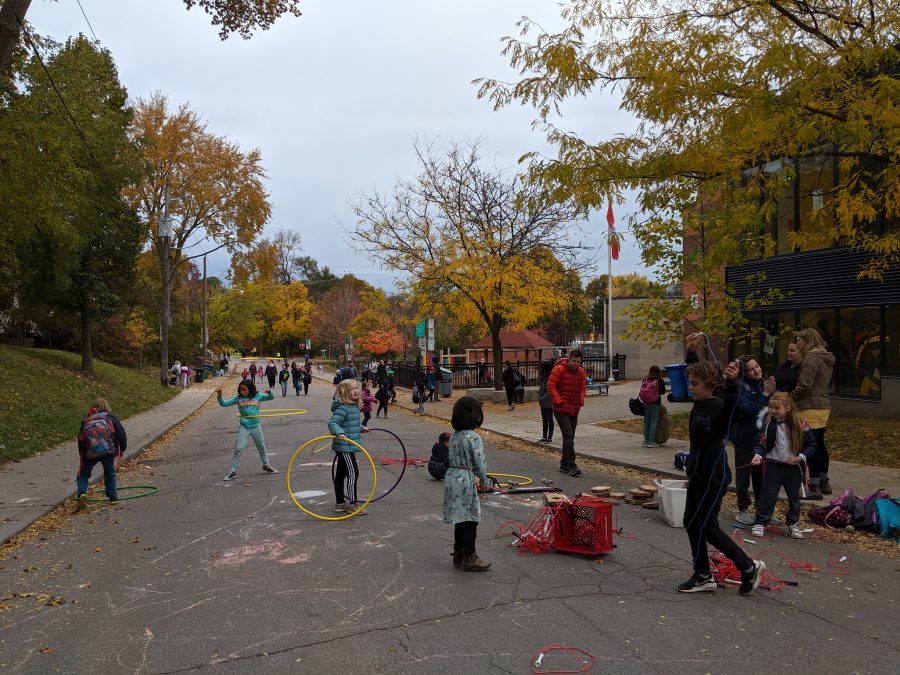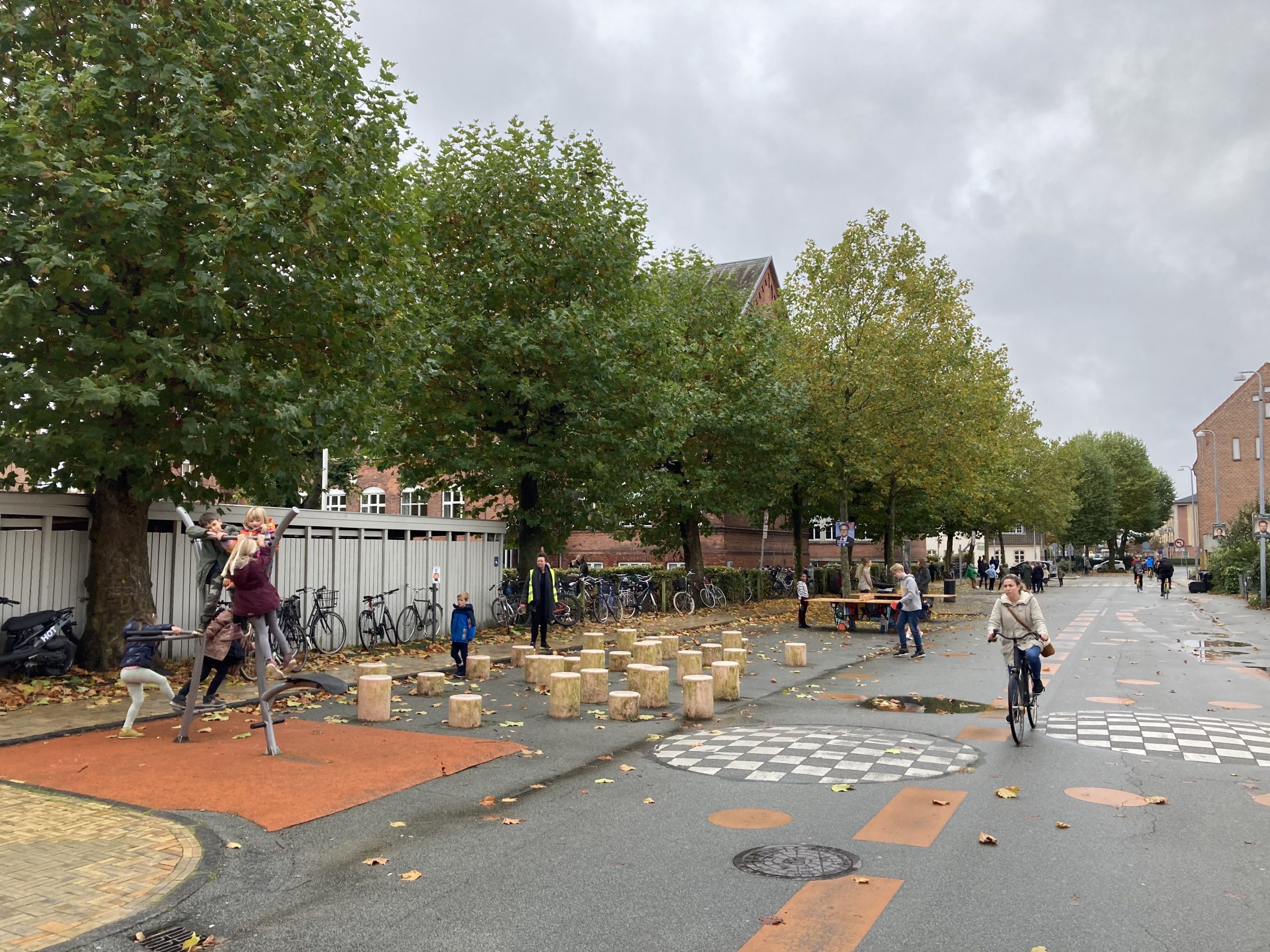8 min read.
Lucas Snaije, & Daniela Abril Gutierrez, are the co-authors of the report “School Streets to Shape Child Friendly Cities“, highlighted in this editorial.
The sound of children playing is universal. Whether in a playground in Paris, a public park in Buenos Aires, a schoolyard in Mumbai, or a street in Nairobi, young children around the world forge bonds, develop skills and creativity, expend energy, and learn about the world and themselves during play. Outdoor play, especially on streets themselves, is however drastically decreasing in the face of issues such as increased road violence, accessible street space for pedestrians, and poor air quality. In the UK for example, children spend half the time playing outside in comparison to their parents. This statistic alone reveals a need to amplify the efforts to and strategies that respond to the reduction of outdoor activity and healthy living.
Developing School Streets is one of those strategies that has benefits that also go beyond creating spaces for play. Indeed, they are becoming a rapidly embraced, low-cost, and simple intervention to reduce vehicle usage, pollution, improve safety, as well as increase walking and cycling. They take the shape of road closures to restrict motorised traffic, where walking and cycling zones are created in front of schools, at least during drop-off and pick-up times, and have shown measurable, positive impacts that should encourage cities around the world to consider their implementation.
Their rapid adoption, mainly in European cities, can be linked to the need for safe social distancing near schools during the COVID-19 pandemic, but also as a response to the several crises of road safety, health, and air quality that are severely affecting children around the world.
Children constitute a vulnerable group that is particularly exposed to harmful effects of air pollutants, due to their short height, developing lungs, brains and higher rate of respiration. For example, three-year-olds breathe in twice as much air as adults per unit body weight, and play closer to the ground – where air pollution is often more concentrated. Road Safety is also of critical concern, with 1.35 million people around the world being killed on the roads each year, and road traffic injury the leading cause of death for children and young adults aged 5–29 years. Sedentarisation is another challenge that is of great concern. 81% of adolescents aged 11-17 years globally are insufficiently physically active according to WHO global recommendations on physical activity for health. These troubling statistics underscore the pressing need to promote tactics such as School Streets to promote healthier neighbourhoods, active travel, and safe play spaces.
A large percentage of car trips, especially for school commutes, are for distances that are walkable or cyclable, and School Street initiatives have shown to be effective tools to curb private car use for short trips, as they provide an alternative for parents and children to walk or cycle safely. Transport for London for example estimated in 2018 that 25% of weekday morning peak car trips are for school drop-offs, a total of 254,000 trips a day. This period also coincides with the highest rate of serious injuries casualties under 16 years of age due to road traffic collisions and high pollution levels.
Implementing School Streets could be a practical and achievable measure to reduce children’s exposure to toxic air pollution. In London, School Streets in Lambeth lead to an impressive 23% reduction in nitrogen dioxide (NO2) pollution. The city of Ghent, in Belgium, is another great evidence of this initiative, where the implementation of School Streets showed significant improvements in road safety and air quality, with average NO2 concentrations falling by 20%.

School Street initiatives are also an answer not only to the traffic chaos in front of elementary schools, but also to the increasing lack of exercise among children. The UK based NGO Sustrans has noted for example that teachers find that pupils who cycle or walk to school, arrive more alert and ready to start the day, compared to those who travelled by car. The Child Health Initiative report on London’s air pollution “Every Child’s Right to Breathe”, has also expressed a generational impact of active travel at a young age, as children who walk and cycle are more likely to become adults who do the same. School Streets initiatives have proven to have an effect on modal shifts towards cycling, with Waltham Forest being an example that saw 20% and 10% increase in two primary schools respectively, benefiting over 12,000 pupils.
School Street initiatives have also received overwhelmingly positive support from parents, children, school teachers and the broader community in the high majority of cases. Examples from France, Vienna, London and Toronto show that parents are highly supportive of the interventions. Their testimonies reflected how families and school staff like the additional sense of school community that this strategy brings, especially in a time when the COVID19 pandemic has restricted community engagement. In Toronto for example, 100% of children surveyed during the Mountview Avenue School Street pilot initiative said they preferred their school street car-free. Another example is Paris, where that a vast majority of the 150 “Rues aux Ecoles” implemented have been made into permanent. A survey conducted for UNICEF revealed that 87% of parents are in favour of the initiative. Such strong community acceptance and support for this program helps advocating for scaling School Streets and eventually making them permanent fixtures of our cities.
Lastly, school Streets also increase wellbeing by bringing together families and the broader community in reclaimed urban space, enabling socialisation more easily and for children to play at pick-up and drop-off times. There are several alternatives and good practices for a successful implementation of School Streets, however most of these are characterised by creativity, strong leadership and community involvement, often starting with a pop-up phase, before moving towards an interim phase and finally seeking permanence. Their simplicity, low cost, rapid implementation, high acceptance, and proven effects indicates that transferability is high and that the likelihood of success in different urban contexts is strong.
To understand in further depth the benefits of School Streets, we developed a brief, in partnership with the Clean Cities Campaign, exploring 6 key benefits that School Streets provide and providing 6 key considerations for their successful implementation. School Street initiatives are one of many strategies that can help our cities to become more inclusive, sensitive and sustainable in a moment where tangible action is of utmost importance. The interviews in this issue highlight the voices of key stakeholders working to implementing more child friendly streets and routes to school, with a focus on active mobility as a source of wellbeing. They bring forward important narratives to accompany the stastistics highlighted in our report.
Access the Report
